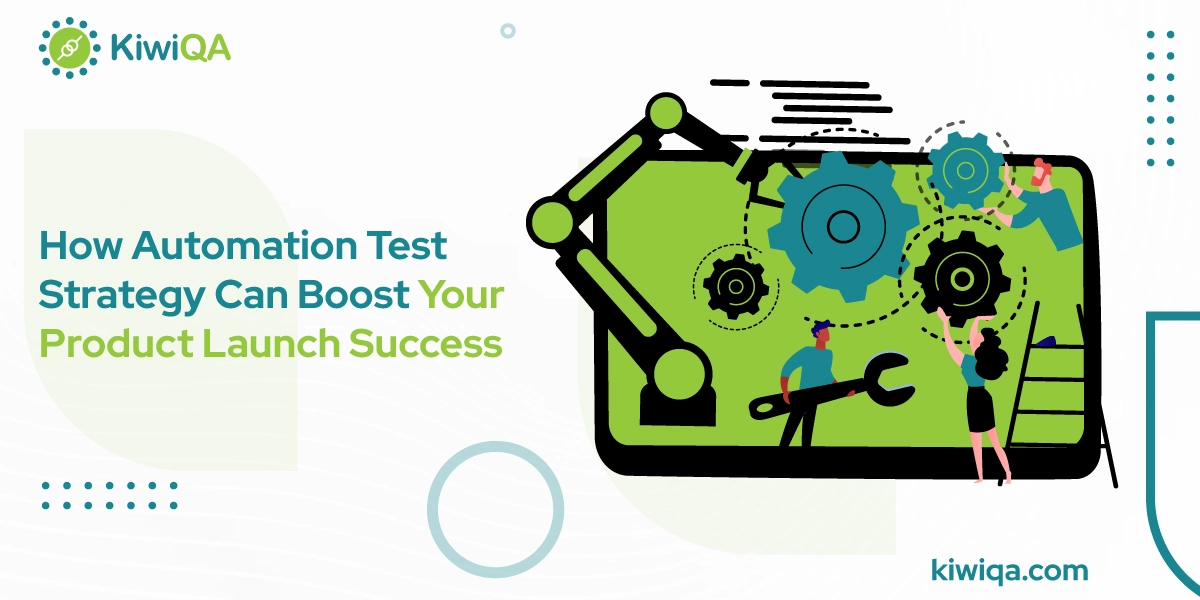Things move at a rapid pace in the software development industry nowadays. Manual testing just cannot keep up with the constant addition of new features and problem fixes. Test automation can help with it. It helps expedite the testing process, find defects more quickly, and ensure that your program is flawless before people see it. As software development’s popularity increases, the necessity of test automation keeps accelerating.
Automation testing services are becoming increasingly important in software development due to the growing demands for quick deployment, smooth cooperation, and unwavering quality standards. These requirements are met by automated testing, which makes it a crucial component of the advancement of software development methodologies.
Test automation strategy is the driving process that enables businesses to reach optimal effectiveness, reliability & innovation in software development. Automated testing decreases the complex task of bug fixing, making it a remarkable option to choose for successful product launching. Based on Forrester, automated testing cut down testing efforts by a significant 75% & expedited market time by 20%.
The following blog contains everything about automated testing in SDLC & its full potential. Read the transformative benefits and navigate challenges that allow businesses to enjoy the full potential of automation.
Understanding the Power of Automation in Product Development
The Speed-Quality Equation
The landscape of development is dynamic, and developers must produce code efficiently. Although crucial, maintaining and upgrading development environments can be tedious and ineffective, diverting developers’ attention from their primary tasks. In software development, automation may increase cooperation, streamline workflow, improve the development process, and ultimately produce greater value.
Automating repetitive operations in product development has a noticeable impact on time to market, enhancing product quality and reducing production costs. Technology is used in product development automation to optimize and simplify several phases of the product lifecycle. Initial design, simulation, prototyping, manufacturing, and even maintenance after production are all included in this.
Test automation strategy in agile greatly accelerates and improves the quality of product development. It speeds up complex methods like deployment and testing. Automated testing and error identification, ensures consistent quality while accelerating time-to-market. Businesses may establish an effective balance between speed and quality by embracing automation, which will eventually spur innovation and improve consumer happiness. The real-time feedback features in the automated testing strategy decrease the chances of delays & diminish the bug’s involvement.
Coverage Without Compromise
Automation in coverage may greatly increase effectiveness and efficiency without sacrificing quality. Automation testing makes it possible to test with little effort across a variety of platforms, devices, and situations. Using automated scripts and tools to run tests does away with the requirement for human interaction and makes testing quicker and more reliable.
Automation testing makes it possible to test with little effort across a variety of platforms, components, and situations. Using a test strategy for automation scripts and tools to run tests does away with the requirement for human interaction and makes testing quicker and more reliable.
Cloud-based automation testing technologies like BrowserStack or TestGrid can be used to automate testing across several devices, platforms, and scenarios easily. Without requiring physical device management, these systems provide effective and scalable testing across several settings through actual device testing, parallel testing, and interactions with CI/CD tools.
Software quality assurance relies heavily on automated regression and performance testing to make sure that new code modifications don’t affect functionality or performance. Automated performance testing ensures that the program stays accessible and stable under various load scenarios. At the same time, automated regression testing confirms that current features continue to function as expected following upgrades.
Also Read: Top 9 Automation Testing Metrics You Should Be Tracking
Crafting a Rock-Solid Automation Test Strategy
Without a plan, starting an automated testing journey is like trying to navigate a ship without knowing the right direction. For a number of reasons, a carefully thought-out automation test planning strategy is essential. Effective software testing is based on a carefully thought-out test automation approach.
In today’s fast-paced software development environment, this strategic viewpoint not only expedites the testing process but also promotes an environment of effectiveness, quality, and flexibility. We’ve put up a list of things to consider while developing your test automation strategy and roadmap. By concentrating on each of these areas, you can create a thorough plan that covers important stages of the automated test life cycle and crucial factors for a successful deployment.
❒ Set Clear Testing Goals from Day One
You should establish specific targets that complement your business objectives in order to gauge the effectiveness of test automation. The common goals of every business include- Cutting down on execution time and raising throughput, Increasing the scope of tests, cutting down on errors, increasing client satisfaction, and boosting ROI. Align your automation efforts with the launch timelines & product vision. Your work will directly support project demands and bring value to the SDLC if you align test automation with business objectives.
An effective automation testing services plan must have well-defined objectives and goals. Without them, your efforts would be aimless, which could result in failure and inefficiency. The foundation for an organized and fruitful automation journey is established by well-defined objectives and targets.
❒ Choose Tools That Fit Like a Glove
The effectiveness of your automation testing strategy and the outcome of your project depends on the technology you use. Every company is different, with different personnel, procedures, and technological systems. When working with different apps in different contexts, each QA team has unique problems. Therefore, it is necessary to meet tool needs with these configurations. When choosing the best tool, consider usability, application support, and budget. Make a shortlist of tools that fit your particular needs.
Your test automation strategy’s success depends on your choice of automation technologies. Automated testing solutions increase project quality, enhance results, speed up time to market, and validate software requirements. There are several tools available, each meeting a distinct set of requirements. Let’s take a sneak peek at those trending tools.
- Cypress– Cypress is a cutting-edge, open-source testing web app framework. Developers and QA engineers use it to automate testing because of its reputation for quick, simple, and dependable end-to-end testing. Cypress is more reliable and quicker since it conducts tests directly within the browser.
- Playwright– An open-source framework called Playwright is used for end-to-end web app testing and cross-browser automation. Its API supports contemporary rendering engines like Chromium, WebKit, and Firefox, and it was created as a test automation framework that is quick, dependable, robust, and evergreen.
- TestCafe– Web testing may be automated with TestCafe, a free and open-source testing platform. A single command may be used to install it on any OS. You may begin testing right away because TestCafe supports JavaScript and TypeScript without the need for configuration.
- Selenium– The main purpose of the open-source automation testing framework Selenium is to validate web applications in various browsers. It guarantees consistent and dependable functionality testing by enabling developers to create automated tests in a variety of programming languages.
- Katalon– With Katalon automation, teams can effectively write, manage, and enhance test scripts for desktop, mobile, API, and online apps without knowing how to code. For more seasoned users who seek customization, a full-code scripting interface is available.
Bonus Tip– Explore AI-powered or low-code testing platforms for greater benefits like enhanced test coverage, less maintenance, and quicker test authoring. Some low-code platforms are ACCELQ and testRigor, whereas the AI-powered testing solutions are Testsigma, TestCraft, BrowserStack, and Mabl.
❒ Prioritize What to Automate (And What Not To)
To get the most out of your QA automation services, you must choose the type of tests to automate. Take into account variables like stability, intricacy, and frequency. Effective test automation requires prioritizing testing types to automate. Tests that depend on exploratory testing, human intuition, or one-time assessments should not be automated. Making a thoughtful test selection guarantees that your automation efforts concentrate on the areas that provide the most returns.
❒ Integrate Automation into Your CI/CD Pipeline
Continuous delivery of high-quality software is ensured by integrating test automation with CI/CD pipelines. Rapid code release is the main goal of continuous integration, which encourages faster feedback and improvements. Automating CI/CD pipelines guarantees that tests are conducted on a regular basis, identifying flaws early and enhancing software quality. During ongoing implementation and delivery, automated testing guarantees performance and quality. It enables parallel testing, in which several test cases run concurrently, enhancing early bug identification and execution efficiency.
How Automation Drives Launch-Day Success
❒ Reduced Time to Market
Accelerating app development cycles is the biggest trait. Testers can swiftly test new features by automating the testing process. Strong interdepartmental communication is developed throughout the testing setup because automated testing can shorten the time needed to finish feedback cycles. Effective communication of appropriate feedback enables each team to expedite their process. Consequently, this will shorten the time it takes for applications to be released.
❒ Confidence Across Teams
Since many testing procedures call for human oversight and labor, test automation is not a substitute for manual testing. Nonetheless, automating some processes may help the testing team to enhance application quality & market time. Manual testing is validated by the vast test automation software technologies. The primary advantage of automated testing is that it saves manual analysts time in developing better test scenarios by relieving them of their tiresome jobs. Therefore, the foundation of test automation is always manual testing.
By improving the testing process’s accuracy, speed, and dependability, automation testing boosts team confidence and results in quicker feedback cycles and higher-quality software. This promotes a more cooperative and effective development environment by raising team morale and facilitating speedier decision-making.
❒ Better First Impressions for Users
By lowering mistakes, guaranteeing consistent operation, and offering a more streamlined, dependable experience, automation testing enhances user first impressions. Early issue detection with automation guarantees that users see a flawless, error-free product right away, improving the first impression.
Automation testing services might make it easier to identify security vulnerabilities early on and address them before they become a problem. Additionally, companies can quickly test all of their critical business applications using automated testing services, eliminating the need to compromise on quality for speed.
There are two choices available to organizations that use manual testing procedures- test slowly and adjust gradually, or test quickly and risk having restricted test coverage.
Automated tests can be performed often to ensure that systems are functioning correctly and in compliance with relevant laws and regulations. Automated testing may be used to confirm that systems are configured correctly and meet all security standards. Consistent and comprehensive testing of systems is crucial for adherence to quality standards and laws, and automated testing may help guarantee this.
Launch-Killers – What to Avoid in Test Automation
❒ Automating unstable features
It is not good to automate testing for unstable features. This may result in wasted work, numerous false failures, and inaccurate testing. Rather, concentrate on automating the most valuable, important, repeatable, and reliable tests. Here’s why it’s troublesome to automate unstable features and what to do instead:
- Regular Script Updates:Test scripts must be updated often due to unstable features that are always changing. This makes it more difficult to guarantee the accuracy of the tests and results in a significant amount of maintenance work.
- Fake Failures:Rather than real issues, tests may fail because of modifications to the unstable feature, producing inaccurate test results and wasting time looking for fake failures.
- Dependency on Automation: Relying too much on automation to handle unstable features might limit the overall flexibility of the testing process and impede the development of human testing abilities.
- Dependency on Automation:Relying too much on automation to handle unstable features might limit the overall flexibility of the testing process and impede the development of human testing abilities.
What to do to avoid?
- Put Stable Features First:Put your attention on automating tests for features that are secure, well-defined, and unlikely to change often.
- Use manual testing:Manual testing works better for exploratory and dynamic features since it makes it easier for testers to adjust to changes.
- Keep Test Scripts Up to Date: Tests should be reviewed and updated often to stay in line with modifications to system behavior or software needs.
- Employ a Strategy for Test Automation:Create a well-defined test automation plan that addresses what should be automated, how to automate it, and how to maintain the tests.
❒ Flaky tests
Automated test cases that fail to yield accurate and predictable outcomes over time are known as flaky tests. Even if the application’s functionality stays the same, they frequently malfunction. The development team may begin to disregard failing tests as a result, which lowers trust in the test suite. You will be unable to identify (and address) flaws in your software if your tests are not reliable, which will ultimately affect the user experience.
- Stabilize the test environment: Unstable test environments frequently result in flaky tests. Ensure the test environment is set up perfectly before beginning the tests. Steer clear of sharing the test environment with other development processes that could have an impact on how the test is executed.
- Employ exact waits:In situations where response timings vary, waiting for items or actions without first waiting for timeouts might result in tests that are brittle. Make use of suitable timeouts and clear waits.
- Record test errors and conduct an investigation:It is required to document the specifics of a test failure, including pertinent logs and information about the test environment.
- Make use of CI/CD:Make sure your CI/CD pipeline includes automated tests and executes them often in various settings. This procedure guarantees that all tests are dependable prior to the code being sent to production by assisting in the early detection of unstable tests in the development cycle.
You can maintain your test automation suite clean and minimize the number of faulty tests by heeding these and other suggestions.
❒ Lack of ownership
In test automation, unclear ownership and accountability for the process can result in a number of challenges, such as poor maintenance, a failure to concentrate on the appropriate tests, and, ultimately, an inability to reap the benefits of automation. A clear ownership structure guarantees that someone is responsible for the development, upkeep, and enhancement of the automation framework and scripts. Here are the ways to avoid lack of ownership-
- Establish Clear Roles and Responsibilities: Make sure that certain people or groups are in charge of various test automation tasks, including writing test scripts, maintaining them, developing frameworks, and reporting on them.
- Encourage Knowledge Sharing: Encourage cooperation and knowledge exchange between the QA team and other automation process stakeholders. Regular meetings, training sessions, and documentation may all help achieve this.
- Assure CI/CD: To guarantee that tests are executed automatically as a deployment process, incorporate test automation into the CI/CD pipeline. This guarantees that the application is constantly in a tested state and aids in the early detection of defects.
- Create a Centralised Repository:All test scripts and documentation should be kept in a centralized repository. Everyone may swiftly access and participate in the automation process.
❒ Ignoring scalability
As systems develop, neglecting scalability in test automation can result in serious problems. This includes lower test coverage, performance snags, and higher maintenance expenses. Prioritize scalability while creating test automation frameworks so that they are adaptable to changing application needs and flexible and modular. Here are the ways to avoid scalability-
- Modular Architecture: To make maintenance and change adaption simpler, divide tests into smaller, reusable components.
- Scalable Automation Framework: Select automation tools and frameworks, including cloud-based platforms or technologies that provide parallel execution and are made to manage demanding testing requirements.
- Data-Driven Testing:Make an investment in a strong data management plan that makes it simple to update and modify test data without compromising the main automation scripts.
- Continuous Integration and Continuous Delivery (CI/CD): Enable quicker feedback and early problem identification by integrating test automation into the CI/CD pipeline to guarantee that tests are executed automatically as part of the deployment process.
- Prioritize Test Maintenance: Make test scripts a priority by reviewing, updating, and maintaining them often to guarantee their correctness and continuous relevance as the program develops.
- Emphasis on Parallel Execution:Reduce the total test execution time and increase throughput by using parallel execution to perform tests across several computers or devices.
- Utilize Reporting and Analytics:To monitor test execution outcomes, spot patterns, and gauge the efficacy of the test automation framework, strong reporting and analysis tools should be put in place.
- Cooperation:To comprehend application requirements and make sure that tests are in line with business requirements, test automation engineers work closely with developers and business analysts.
Building solid and scalable QA automation testing services by adhering to these best practices can help you accomplish your testing objectives, save long-term maintenance expenses, and enhance the quality of your product.
Also Read: How Different Types of User Testing Improve Product Usability
Build Confidence in Every Release with the Right Automation Test Strategy
In today’s fast-paced, intensely competitive business world, organizations are always searching for ways to enhance the quality and efficacy of their software development processes. In order to accomplish these objectives, automated software testing services have become essential, enabling companies to accelerate software testing and guarantee the dependability of their applications. However, the creation of a well-organized carried out Test Automation Strategy is essential to the success of test automation.
Enhancing corporate operations’ speed, precision, and efficiency through automation is essential for raising output and cutting expenses. Additionally, it facilitates improved cooperation, risk reduction, and compliance maintenance. Ultimately, it improves overall corporate productivity and is a role of the online revolution. To automate & boost your product launch success, hire experts from automation testing services company.
Product launches require a different approach in the digital era. It requires an effective fusion of strategic use of digital platforms, deliberate innovation, well-considered planning, and data analysis. For a digital product launch to be successful, keep in mind that communication, consistency, and careful monitoring of your strategies are crucial. Although it could seem like a daunting task, it will help you navigate this complex process and increase the likelihood that your product will have a significant impact on the market.
You’ve studied the principles of developing a strong test automation plan and found best practices for its smooth execution. It’s time to put theory into practice and see how automated testing can revolutionize your software development process. However, it might be intimidating to navigate the challenges of developing and putting into practice a successful test automation approach. So, here, the automated testing company helps you.







